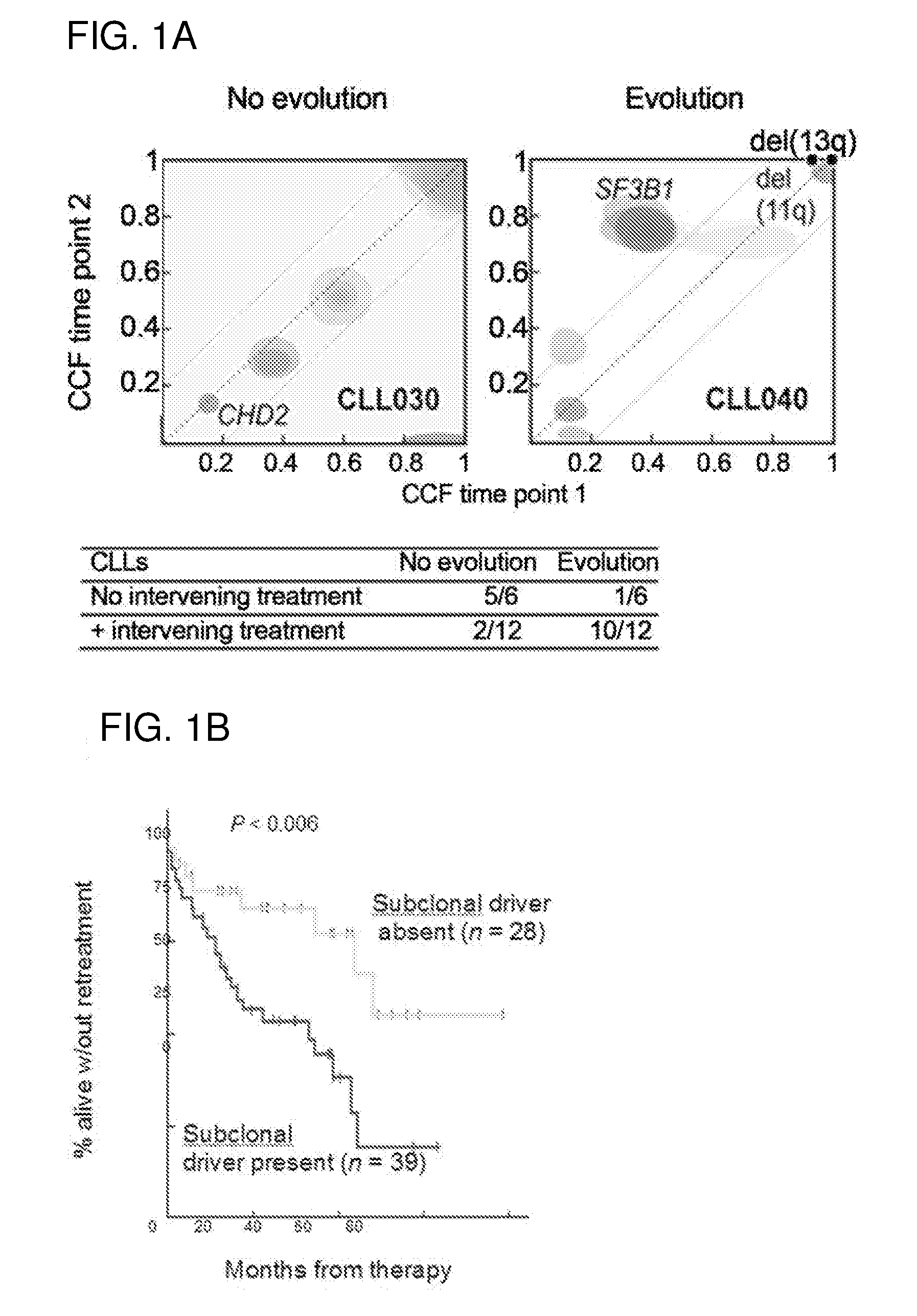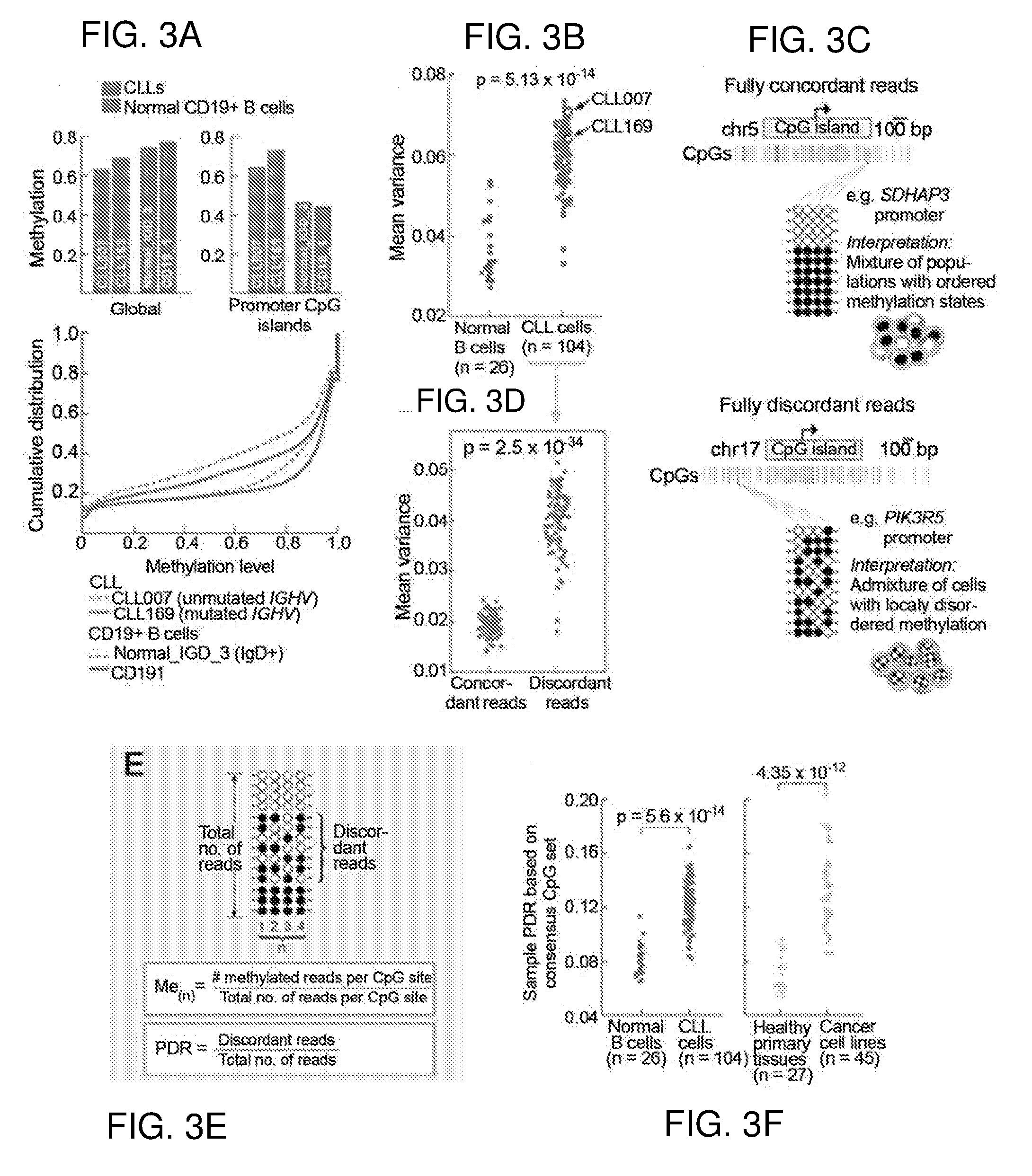Compositions and methods for diagnosing, evaluating and treating cancer
a cancer and cancer technology, applied in the field of cancer diagnostics, evaluating and treating cancer, can solve the problems of common leukemia remaining incurable, phenotypic differences in survival capacity and proliferative potential, and disease recurrence, so as to reduce the potential evolutionary capacity of cancer
- Summary
- Abstract
- Description
- Claims
- Application Information
AI Technical Summary
Benefits of technology
Problems solved by technology
Method used
Image
Examples
example 1
Genetic Heterogeneity is Associated with Clonal Evolution
[0191]Applicants used an analytic approach in which whole-exome sequencing (WES) was used to infer the fraction of cancer cells (CCF) that harbors each somatic mutation in 149 CLLs by correcting the allelic fraction measured by WES for sample purity and local copy number at the mutated sites. To directly assess clonal evolution (FIG. 1A), Applicants compared CCF for each mutation at 2 time points in 18 CLL cases (median interval between time points 3.5 yrs.). Applicants observed a higher rate of clonal evolution in 12 cases that received treatment between time points compared with 6 continuously untreated cases (P=0.012). Clonal evolution involved the expansion of subclones that harbored mutations highly enriched in driver mutations. These subclonal driver mutations were often already detectable in the pretreatment sample (red clusters, FIG. 1A right). Applicants therefore hypothesized that the pretreatment detection of subclo...
example 2
DNA Methylation Heterogeneity in CLL
[0192]While investigations of evolutionary dynamics in cancer have focused primarily on the role of genetic alterations, epigenetic modifications are likely also responsible for the phenotypic differences that ultimately affect fitness.
[0193]Applicants therefore assessed the degree of DNA methylation heterogeneity in CLL. Applicants performed a re-analysis of a published set of DNA methylation arrays (Kulis M, et al. Nat Genet, 2012; 44:1236-42) and found that the 127 CLL samples showed a higher degree of DNA methylation heterogeneity compared with 25 normal B cell samples (FIG. 2A-B). Applicants confirmed the higher heterogeneity in CLL by reanalyzing published whole genome bisulfite sequencing (WGBS) data (FIG. 2C). Applicants also studied this question with reduced representation bisulfite sequencing (RRBS) which allowed the use of MPS technology to study DNA methylation in larger cohorts. Applicants found higher methylation heterogeneity in CL...
example 3
Increased Intra-Sample DNA Methylation Heterogeneity in CLL Arises from Locally Disordered Methylation
[0194]To measure intra-sample CLL DNA methylation heterogeneity, Applicants compared WGBS data generated from two CLL cases and two healthy donor B cell samples (FIG. 3A). Applicants observed globally decreased methylation in CLL compared to normal B cells, with focally increased methylation of CpG islands (CGI) (FIG. 3A—top, FIG. 4A-C), as previously reported in CLL and other cancers (Baylin and Jones, 2011; Kulis et al., 2012), but also a markedly increased frequency of intermediate methylation values in CLL (FIG. 3A-bottom, FIG. 4A-D), pointing to a large proportion of CpGs that are methylated in some cells in the sample and unmethylated in others. Applicants reanalyzed published WGBS and 450K methylation array data (Kulis et al., 2012) and confirmed the increased cell-to-cell variability in CpG methylation in CLL compared to normal B cells (FIG. 4E-H).
[0195]Applicants next appli...
PUM
| Property | Measurement | Unit |
|---|---|---|
| median time | aaaaa | aaaaa |
| resistance | aaaaa | aaaaa |
| methylation entropy | aaaaa | aaaaa |
Abstract
Description
Claims
Application Information
 Login to View More
Login to View More - R&D
- Intellectual Property
- Life Sciences
- Materials
- Tech Scout
- Unparalleled Data Quality
- Higher Quality Content
- 60% Fewer Hallucinations
Browse by: Latest US Patents, China's latest patents, Technical Efficacy Thesaurus, Application Domain, Technology Topic, Popular Technical Reports.
© 2025 PatSnap. All rights reserved.Legal|Privacy policy|Modern Slavery Act Transparency Statement|Sitemap|About US| Contact US: help@patsnap.com



